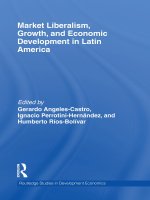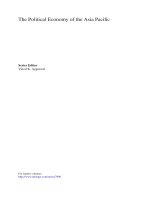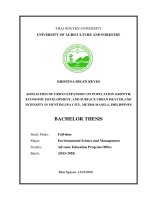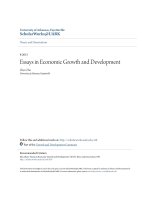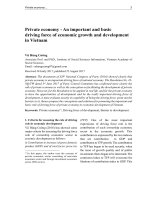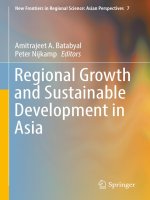Economic growth and economic development 705
Bạn đang xem bản rút gọn của tài liệu. Xem và tải ngay bản đầy đủ của tài liệu tại đây (128.68 KB, 1 trang )
Introduction to Modern Economic Growth
Moreover, it can be verified that the equilibrium interest rate is given by (see Exercise
15.24):
(15.49)
1
" µ
# σ−1
¶ σ−1
σ
NL (t) L
+ (1 − γ)
.
r (t) = β (1 − γ) NK (t) γ
NK (t) K (t)
Let us now define a constant growth path as one in which consumption grows
at a constant rate. From (15.22), this is only possible if r (t) is constant. Equation
(15.48) implies that (NL (t) L) / (NK (t) K (t)) is constant, thus NK (t) must also be
constant. Therefore, equation (15.48) implies that technological change must be
purely labor augmenting. Thus we have obtained the following proposition:
Proposition 15.14. Consider the baseline model of directed technological change
with the two factors corresponding to labor and capital. Suppose that the innovation
possibilities frontier is given by the knowledge spillovers specification and extreme
state dependence, i.e., δ = 1 and that capital accumulates according to (15.46).
Then there exists a constant growth path allocation in which there is only laboraugmenting technological change, the interest rate is constant and consumption and
output grow at constant rates. Moreover, there cannot be any other constant growth
path allocations.
Proof. Part of the proof is provided by the argument preceding the proposition.
Exercise 15.25 asks you to complete the proof and show that no other constant
constant growth path allocation can exist.
Ô
It can also be verified that the constant growth path allocation with purely labor augmenting technological change is globally stable if σ < 1 (see Exercise 15.26).
This is reasonable, especially in view of the results in Proposition 15.7, which indicated that the stability of equilibrium dynamics in the model with the knowledge spillovers requires σ < 1/δ. Since here we have extreme state dependence,
δ = 1, stability requires σ < 1. Intuitively, if capital and labor were gross substitutes (σ > 1), the equilibrium would involve rapid accumulation of capital and
capital-augmenting technological change, leading to an asymptotically increasing
growth rate of consumption. However, when capital and labor are gross complements (σ < 1), capital accumulation would increase the price of labor and profits
691
